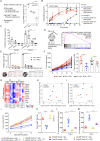Glucocorticoid activation by HSD11B1 limits T cell-driven interferon signaling and response to PD-1 blockade in melanoma
- PMID: 37028818
- PMCID: PMC10083881
- DOI: 10.1136/jitc-2021-004150
Glucocorticoid activation by HSD11B1 limits T cell-driven interferon signaling and response to PD-1 blockade in melanoma
Abstract
Background: Immune responses against tumors are subject to negative feedback regulation. Immune checkpoint inhibitors (ICIs) blocking Programmed cell death protein 1 (PD-1), a receptor expressed on T cells, or its ligand PD-L1 have significantly improved the treatment of cancer, in particular malignant melanoma. Nevertheless, responses and durability are variables, suggesting that additional critical negative feedback mechanisms exist and need to be targeted to improve therapeutic efficacy.
Methods: We used different syngeneic melanoma mouse models and performed PD-1 blockade to identify novel mechanisms of negative immune regulation. Genetic gain-of-function and loss-of-function approaches as well as small molecule inhibitor applications were used for target validation in our melanoma models. We analyzed mouse melanoma tissues from treated and untreated mice by RNA-seq, immunofluorescence and flow cytometry to detect changes in pathway activities and immune cell composition of the tumor microenvironment. We analyzed tissue sections of patients with melanoma by immunohistochemistry as well as publicly available single-cell RNA-seq data and correlated target expression with clinical responses to ICIs.
Results: Here, we identified 11-beta-hydroxysteroid dehydrogenase-1 (HSD11B1), an enzyme that converts inert glucocorticoids into active forms in tissues, as negative feedback mechanism in response to T cell immunotherapies. Glucocorticoids are potent suppressors of immune responses. HSD11B1 was expressed in different cellular compartments of melanomas, most notably myeloid cells but also T cells and melanoma cells. Enforced expression of HSD11B1 in mouse melanomas limited the efficacy of PD-1 blockade, whereas small molecule HSD11B1 inhibitors improved responses in a CD8+ T cell-dependent manner. Mechanistically, HSD11B1 inhibition in combination with PD-1 blockade augmented the production of interferon-γ by T cells. Interferon pathway activation correlated with sensitivity to PD-1 blockade linked to anti-proliferative effects on melanoma cells. Furthermore, high levels of HSD11B1, predominantly expressed by tumor-associated macrophages, were associated with poor responses to ICI therapy in two independent cohorts of patients with advanced melanomas analyzed by different methods (scRNA-seq, immunohistochemistry).
Conclusion: As HSD11B1 inhibitors are in the focus of drug development for metabolic diseases, our data suggest a drug repurposing strategy combining HSD11B1 inhibitors with ICIs to improve melanoma immunotherapy. Furthermore, our work also delineated potential caveats emphasizing the need for careful patient stratification.
Keywords: CD8-positive T-lymphocytes; immunotherapy; interferon; melanoma; programmed cell death 1 receptor.
© Author(s) (or their employer(s)) 2023. Re-use permitted under CC BY-NC. No commercial re-use. See rights and permissions. Published by BMJ.
Conflict of interest statement
Competing interests: None declared.
Figures






References
Publication types
MeSH terms
Substances
LinkOut - more resources
Full Text Sources
Medical
Research Materials
